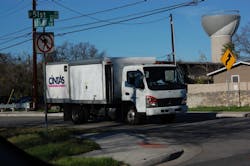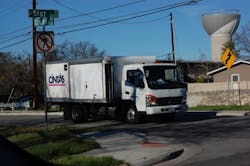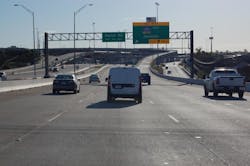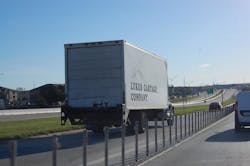One of the more interesting discussions that came out of the 95th annual meeting of the Transportation Research Board (TRB) in Washington D.C. this week centered on how to accommodate freight needs more prominently into city planning processes.
That may seem a very broad and unforgivably dull subject – “Let us be honest: freight isn’t sexy. No one does this for the fun of it,” noted Ian Wainwright, head of freight and fleet programs at Transport for London, one of the session’s four panelists – but it’s extremely critical as cities around the world become ever denser and larger, which will drive up freight demand in unexpected ways.
Think about this factoid, for example: About 80 buildings in Manhattan produce 4% to 8% of New York City’s total freight traffic. In other words, they produce more traffic than the Port of New York and New Jersey, noted Professor José Holguín-Veras with the Volvo Research and Educational Foundations (VREF) Center of Excellence on Sustainable Urban Freight Systems at the Rensselaer Polytechnic Institute.
“When people think of large ‘traffic generators,’ many think about ports, large warehouses, and truck terminals. Not in urban areas,” he explained. “We also overlook internet deliveries, which produces urban congestion and pollution. Thus we need to accommodate not just the needs of freight but of commercial establishments that need freight delivered and picked up.”Holguin-Veras stressed that city planners need to “push” not for accommodations for freight but rather for the “proactive integration” of urban economies and activities.
“Freight is the expression of economic activity,” he emphasized, noting that city planning models need to work with employment data, particularly by business sector, rather than the traditional “land-use” factors typically used to calculate freight transport needs.
“Economic activity creates freight trips,” Holguin-Veras added. “But trying to convince policy makers we need to help freight and the truckers is like trying to ask them to provide help for bad guys in the movies. What we need to do is rephrase the discussion: Do you want restaurants to have fresh food or stores to have full shelves?”
Maria Lindholm, director of the competence center at management consulting firm Northern LEAD, noted that such issues are critical when trying to build “sustainable” urban freight transport strategies.
Her company is working with the city of Gothenburg in Sweden as part of its DenCity project that seeks to address how sustainable urban mobility for both people and goods can be provided in an area characterized by compact land use.
“It’s about where freight fits into more dense urban areas,” she explained. “It’s about developing more space-efficient freight logistics centers, generating less emissions, and also whether we can develop models to get the populace to pay for this.”
Ideas Gothenburg is experimen“The key thing is have to plan from the beginning,” she said. “Politicians want to see numbers; especially [in terms of] what happens if we don’t do something. Showing the importance of freight is important to do [and] maybe the ‘frightening’ scenarios are part of that.”
John Orr, a senior principal planner with the Atlanta Regional Commission, stressed something else, too: Trying to fix and/or retrofit problems caused when freight needs are overlooked is more expensive in many cases compared to if freight needs are just included right from the start.
“Ultimately, elected officials are sensitive to their constituents’ opinions, and when constituents take stands on livability, elected officials pay attention to that,” he said.“But when it comes to livability and freight, when you are retrofitting large scale urban developments in cities, often there are disagreements how to move freight within those urban areas,” Orr pointed out. “Over time, you need to know how to accommodate new levels of goods movement. That means we need to make mistakes, so that will be lessons learned.”
Professor Michael Browne – chairman of logistics and urban freight transport at the University of Gothenburg’s department of business administration – stressed, however, that the “fear” among city planners is that if politicians in particular don’t know what to do about a problem, they “look away” from the issue in the hopes it will dissipate.
“But looking away won’t solve the problem,” he emphasized. “Thus how we frame the question of freight, the terms we use, and the ways to make change happen are really important. The implications are that they [politicians] are not listening, but perhaps we’re not explaining [freight needs] effectively. We have a lot of good intentions, but we’re not successful enough in communicating them.”
Browne believes the door is “half open” to the discussion of freight needs within the urban planning process. “People are open to discussing this. But the question is: do we barge the door open or knock politely? Perhaps we need to be willing to barge the door open.”



